Parsvakonasana (Extended Side Angle Pose) is a foundational standing pose that develops stability, strength, and mobility. From a wide-legged lunge, the front knee bends directly above the ankle while the torso extends laterally over the front thigh. One arm reaches toward the floor while the other stretches upward or overhead. Practising Parsvakonasana systematically improves hip opening, spinal rotation, balance, and overall body awareness.
This in-depth tutorial explores Parsvakonasana through a series of nine progressively structured variations. Each variation isolates a key action — helping you build strength, mobility, and precision as you move toward the full classical pose. Follow the step-by-step breakdown to deepen your understanding, improve alignment, and develop a stronger, more expansive practice.
📚 On This Page
- ▶️ Watch the Free Step-by-Step Video on Parsvakonasana
-
▶️ Nine Parsvakonasana Variations to Build Technique and Strength
- ➡️ 1. Foundational Leg and Hip Actions in Virabhadrasana II
- ➡️ 2. Parsvakonasana with Vertical Arm: Foundation for Hip Opening and Spinal Rotation
- ➡️ 3. Parsvakonasana with a Belt for Chest Rotation
- ➡️ 4. Blanket-Assisted Waist Contact
- ➡️ 5. Chair-Assisted Parsvakonasana
- ➡️ 6. Parsvakonasana with Foot on a Slanted Block and Wall Support
- ➡️ 7. Parsvakonasana with Top Hand to the Wall
- ➡️ 8. Parsvakonasana Arm Preparation: Lifting and Turning into Final Position
- ➡️ 9. Parsvakonasana: Final Classical Version
- ▶️ Conclusion
Watch the Free Step-by-Step Video on Parsvakonasana
Follow along with this detailed video tutorial to experience each variation firsthand and refine your practice of Parsvakonasana.
Nine Parsvakonasana Variations to Build Technique and Strength
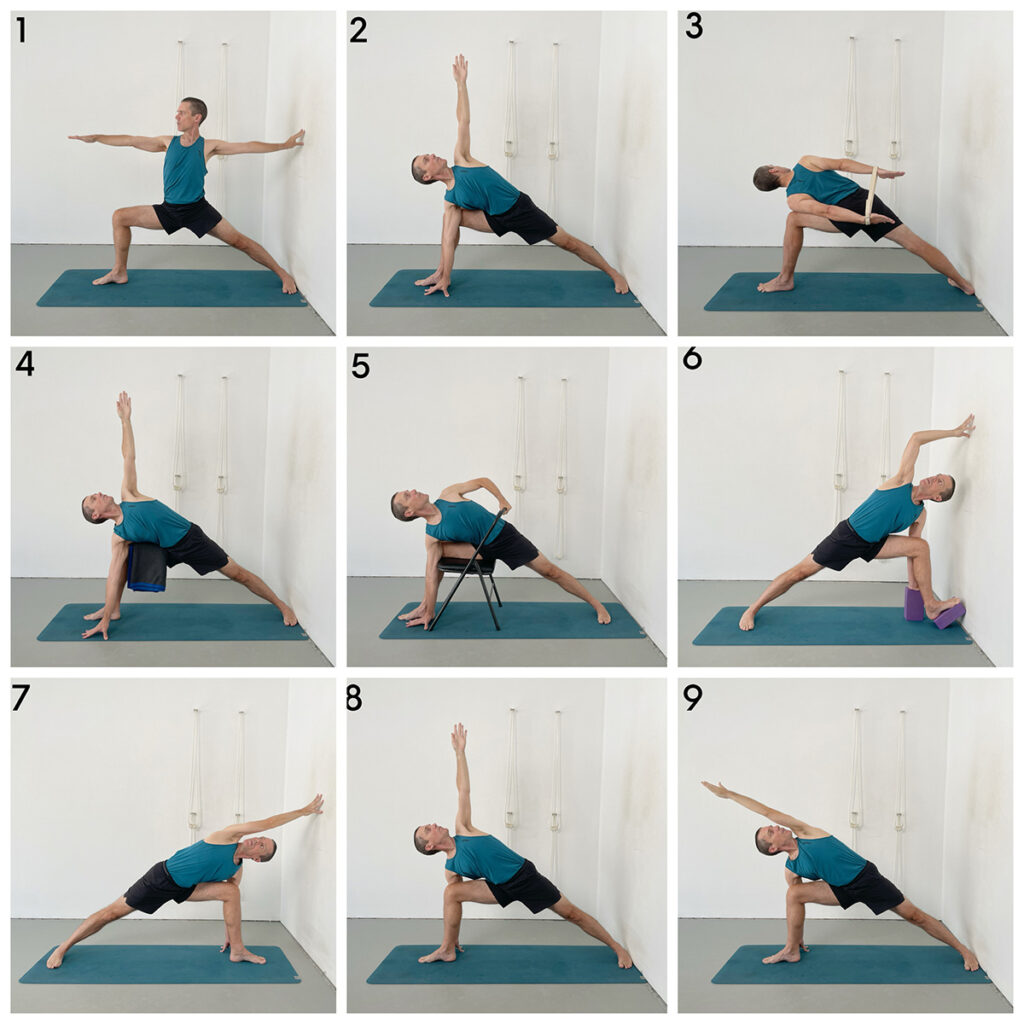
Explore the key stages of Parsvakonasana development through nine progressively structured variations designed to build strength, mobility, and precision.
1. Foundational Leg and Hip Actions in Virabhadrasana II
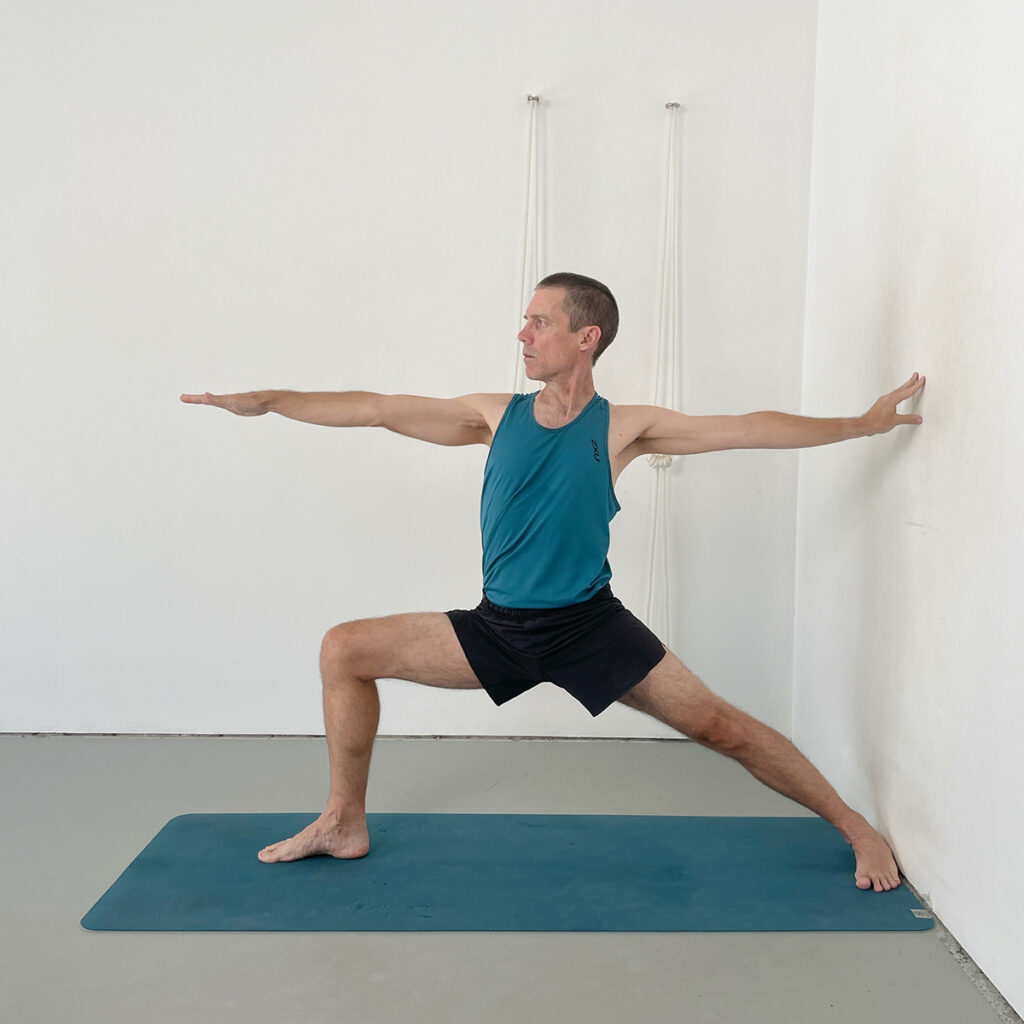
Technique Focus: Establish correct leg, hip, and shoulder alignment to build a stable base for Parsvakonasana.
- Place the back heel to the wall and step the front foot out to a wide distance (slightly greater than one leg’s length).
- Bend the front knee deeply, ensuring the thigh is parallel to the floor.
- Press the front heel down, draw the outer thigh back toward the wall, and move the front hip inward.
- Press the back heel firmly into the floor to stabilize the back leg, contain the back thigh, and draw the back hip inward to support the spinal base.
- Extend the arms, lift the chest, and ensure the back shoulder aligns over the back hip.
2. Parsvakonasana with Vertical Arm: Foundation for Hip Opening and Spinal Rotation
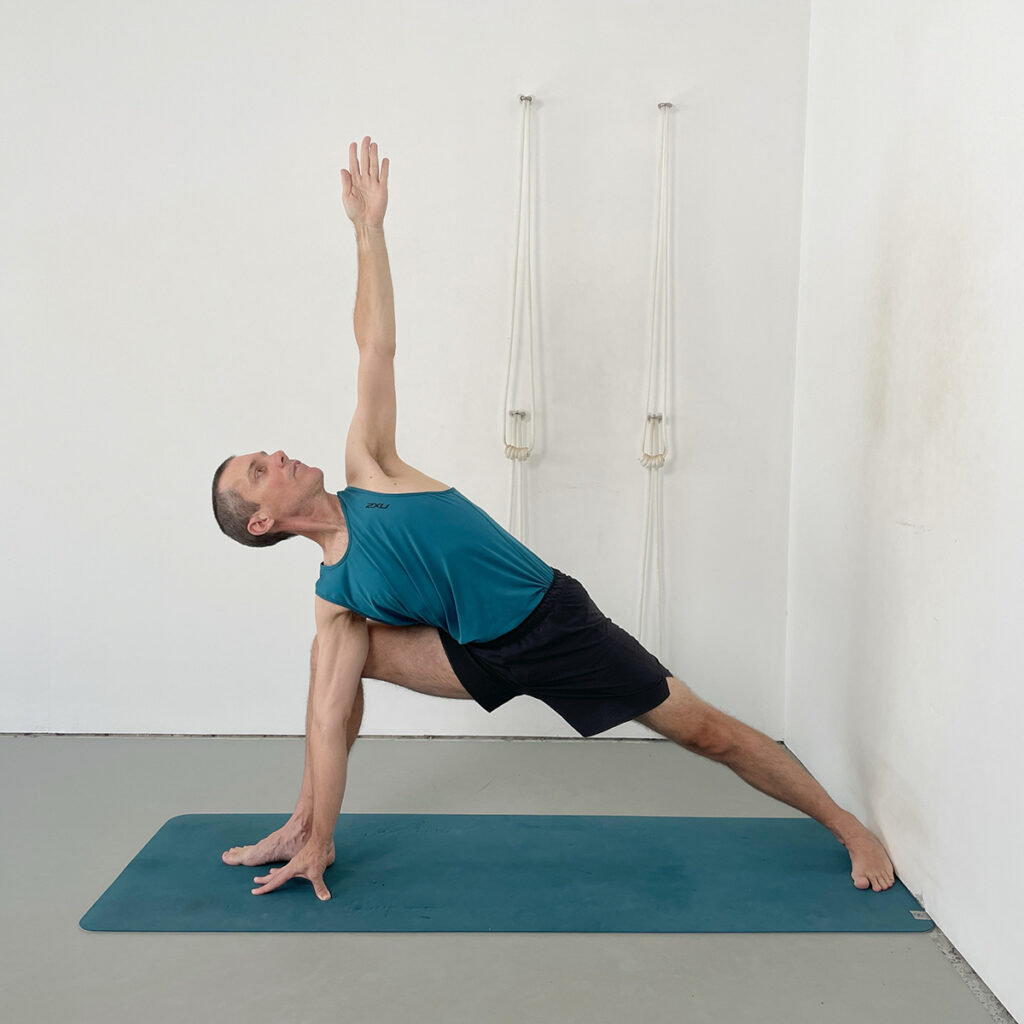
Technique Focus: This introductory variation emphasizes establishing a strong waist-to-thigh connection while maintaining a vertical top arm. It helps newer students open the hips, align the legs, and prepare for deeper spinal rotation, setting a foundation for the classical form of Parsvakonasana.
- Bend the front knee deeply and place the hand on the floor beside the foot.
- Sink the thigh and bring the waist down towards the thigh.
- Press the front heel down firmly to initiate a chain of actions: draw the outer thigh back toward the wall and move the front hip inward to correct hip alignment.
- Use the bottom arm to press into the floor and turn the chest upward.
- Press the back heel firmly into the floor to stabilize the back leg, and use this grounding action to draw the top shoulder back and open the chest upward.
3. Parsvakonasana with a Belt for Chest Rotation

Technique Focus: Use a belt to create resistance that assists in chest lift and rotation while maintaining waist-thigh contact.
- Create a belt loop around the wrists, keeping wrists shoulder-width apart.
- Hold the belt behind the back and press outward against it.
- Bend the front knee and bring the chest and waist to the thigh.
- Use the belt’s resistance to rotate the chest upward.
- Keep both wrists active against the belt to assist shoulder and chest opening.
4. Blanket-Assisted Waist Contact
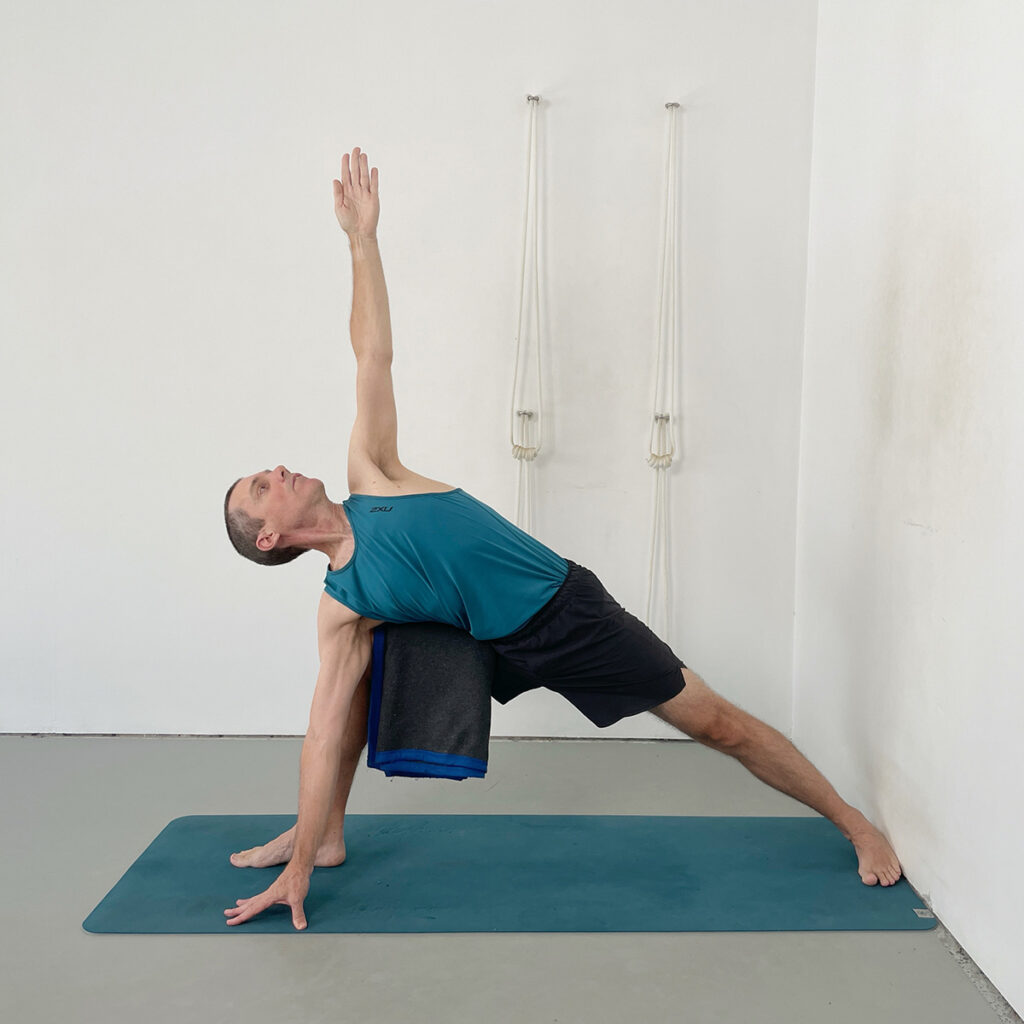
Technique Focus: Use a blanket at the thigh crease to heighten awareness of waist-to-thigh contact and encourage greater turning through the waist.
- Fold a blanket neatly and place it into the front thigh crease.
- Bend the front knee and sink the waist deeply onto the blanket.
- Keep the hip contained and the front thigh descending.
- Press the bottom hand to the floor and resist the arm against the knee.
- Use the resistance to turn the waist and chest upward.
5. Chair-Assisted Parsvakonasana
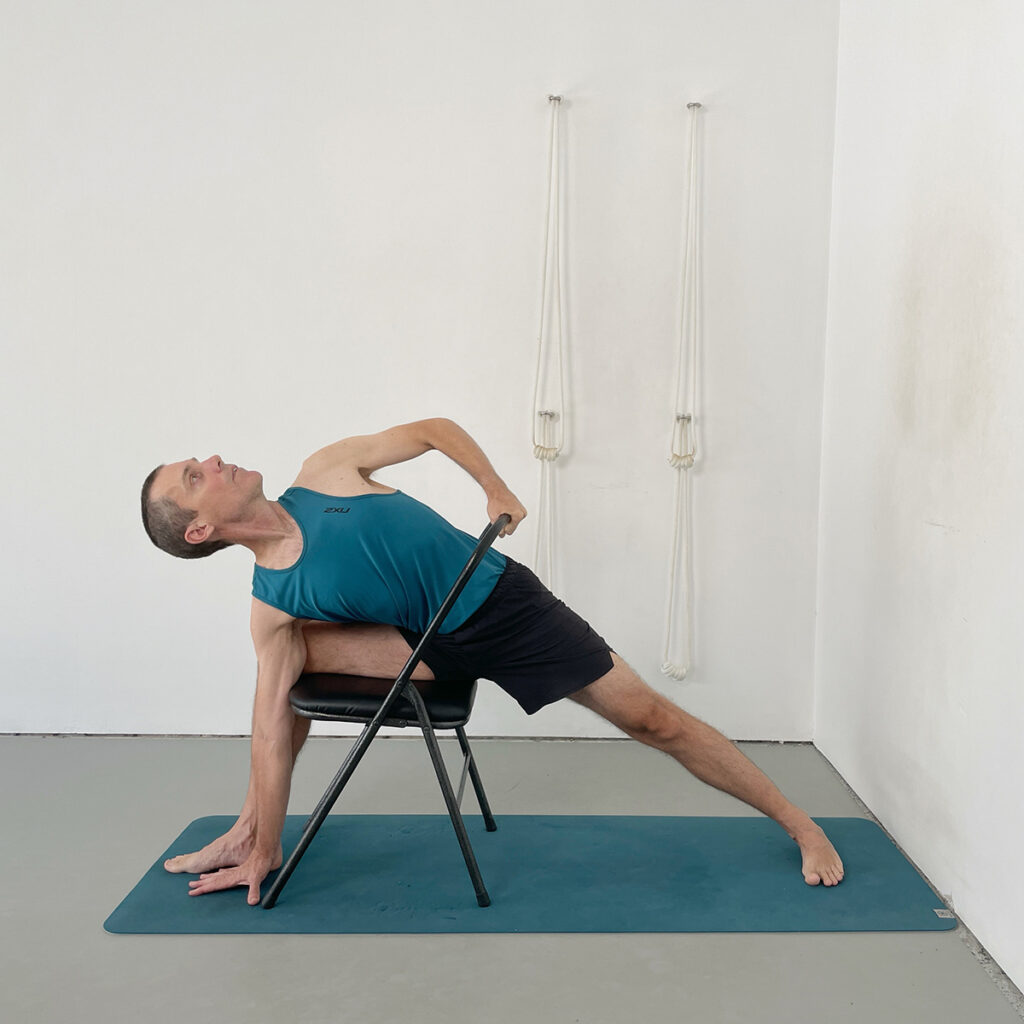
Technique Focus: Use a chair to support the full weight of the front leg, allowing the thighbone to sink deeply and release effort. This stabilizes the pose, encourages greater waist-to-thigh connection, and facilitates deeper chest and waist rotation.
- Position a chair under the front thigh, adjusting height as needed.
- Bend the front knee so the thigh rests fully on the chair.
- Bring the bottom hand to the floor and wedge the arm against the knee.
- Press the top hand into the chair frame to assist chest and waist rotation.
- Walk the top hand around the chair frame to deepen the turning action.
6. Parsvakonasana with Foot on a Slanted Block and Wall Support
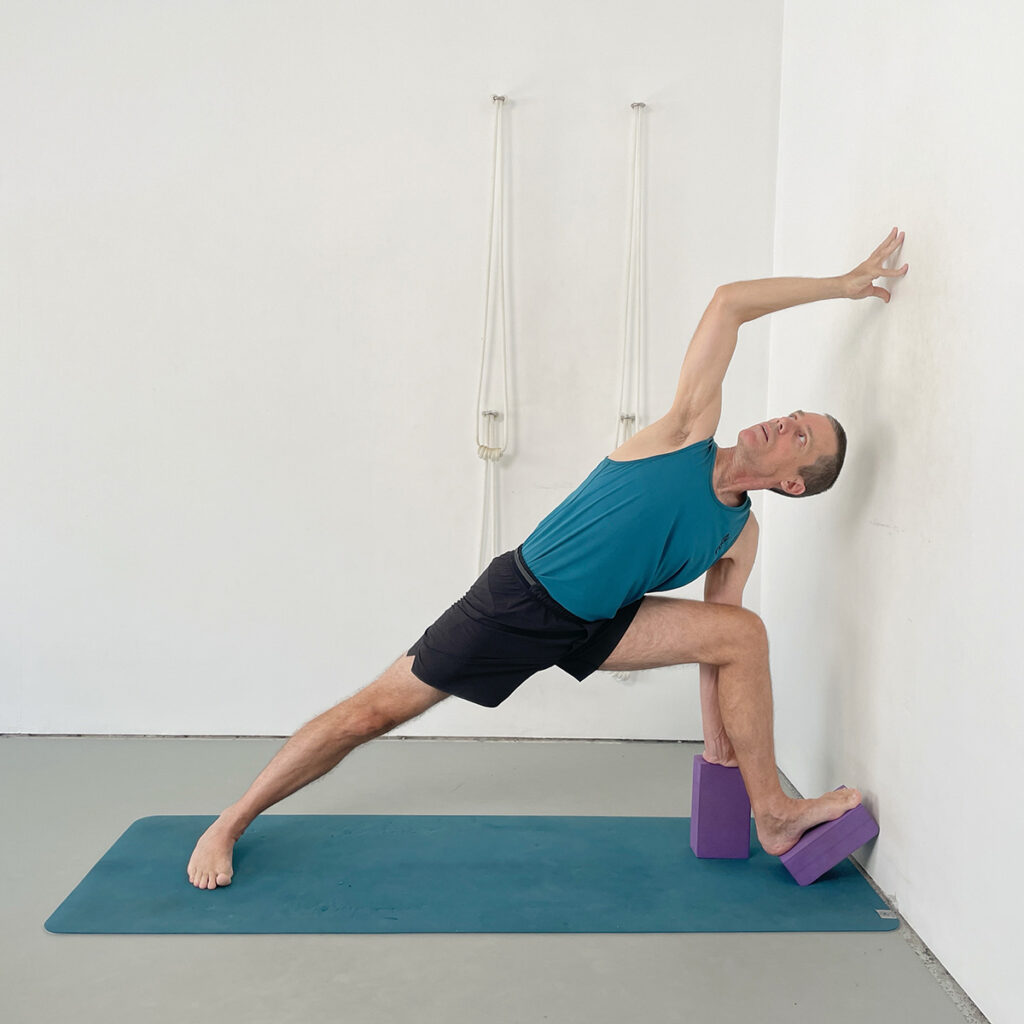
Technique Focus: The slanted block helps open the front hip by stabilizing the foot and thigh, while the position created allows the top arm to be more effectively utilized to deepen the twisting action of the pose.
- Place the front foot on a slanted block, keeping the back foot grounded firmly on the floor without wall support.
- Bend the front knee and bring the bottom hand to a tall block.
- Stabilize the body by pressing the front foot down firmly into the block and grounding the back foot steadily onto the floor.
- Bring the top hand to the wall with the elbow pointing up.
- Use the wall to leverage the top arm and deepen the chest and waist rotation.
7. Parsvakonasana with Top Hand to the Wall

Technique Focus: Fully extend the top arm against the wall to coordinate top arm action with back leg grounding and enhance rotational lift.
- Step slightly away from the wall and bend the front knee.
- Place the bottom hand on the floor and extend the top arm fully along the wall.
- Straighten the top elbow and press firmly into the wall.
- Anchor the back heel and lift the top arm while turning the waist and chest upward.
- Walk the top hand further along the wall to refine the overhead line.
8. Parsvakonasana Arm Preparation: Lifting and Turning into Final Position
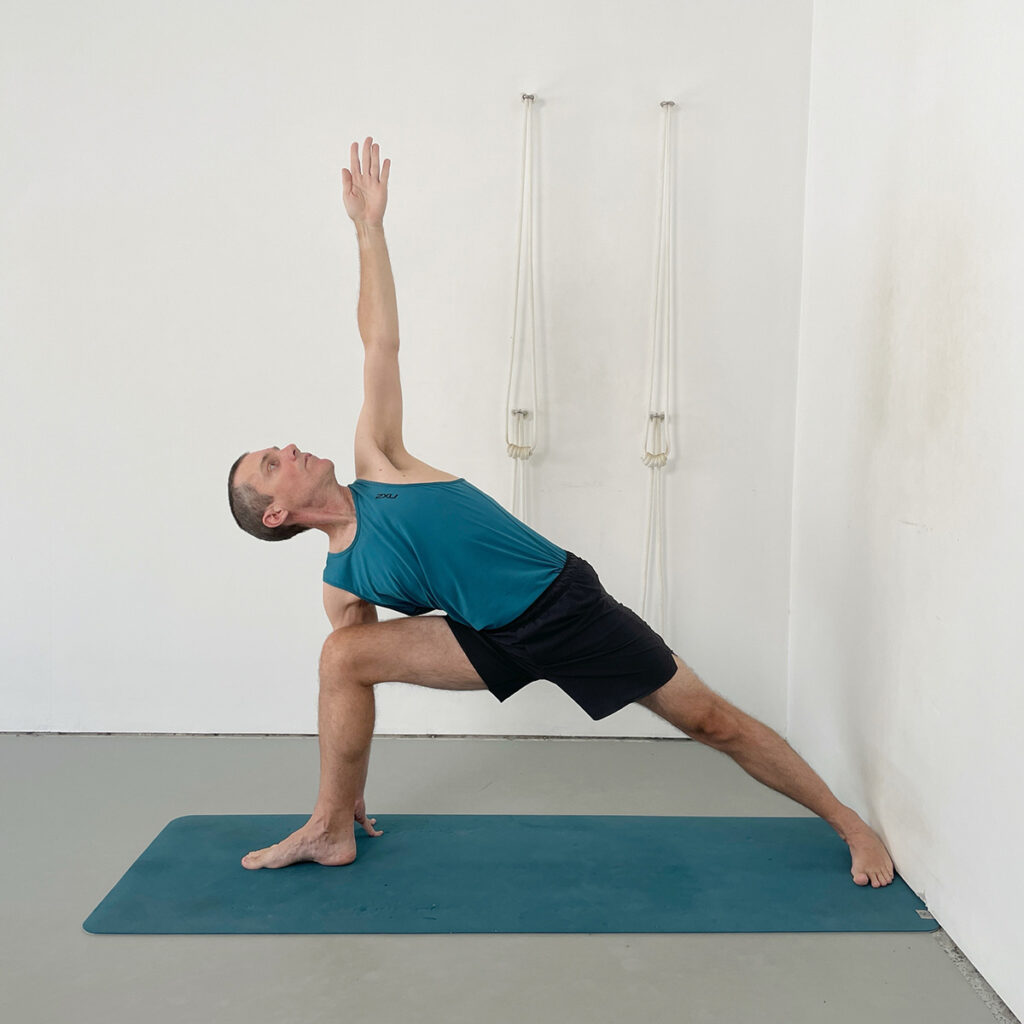
Technique Focus: Coordinate the progressive lifting and rotation of the arm by synchronizing movement through the wrist, elbow, and shoulder.
- Step slightly away from the wall and bend the front knee.
- Bring the bottom hand to the floor and lift the top arm vertically upward.
- Straighten the top elbow fully while rotating the forearm externally.
- Lift through the wrist, elbow, and shoulder sequentially to lengthen the arm.
- Maintain the turning of the chest and waist upward as the top arm extends vertically.
9. Parsvakonasana: Final Classical Version
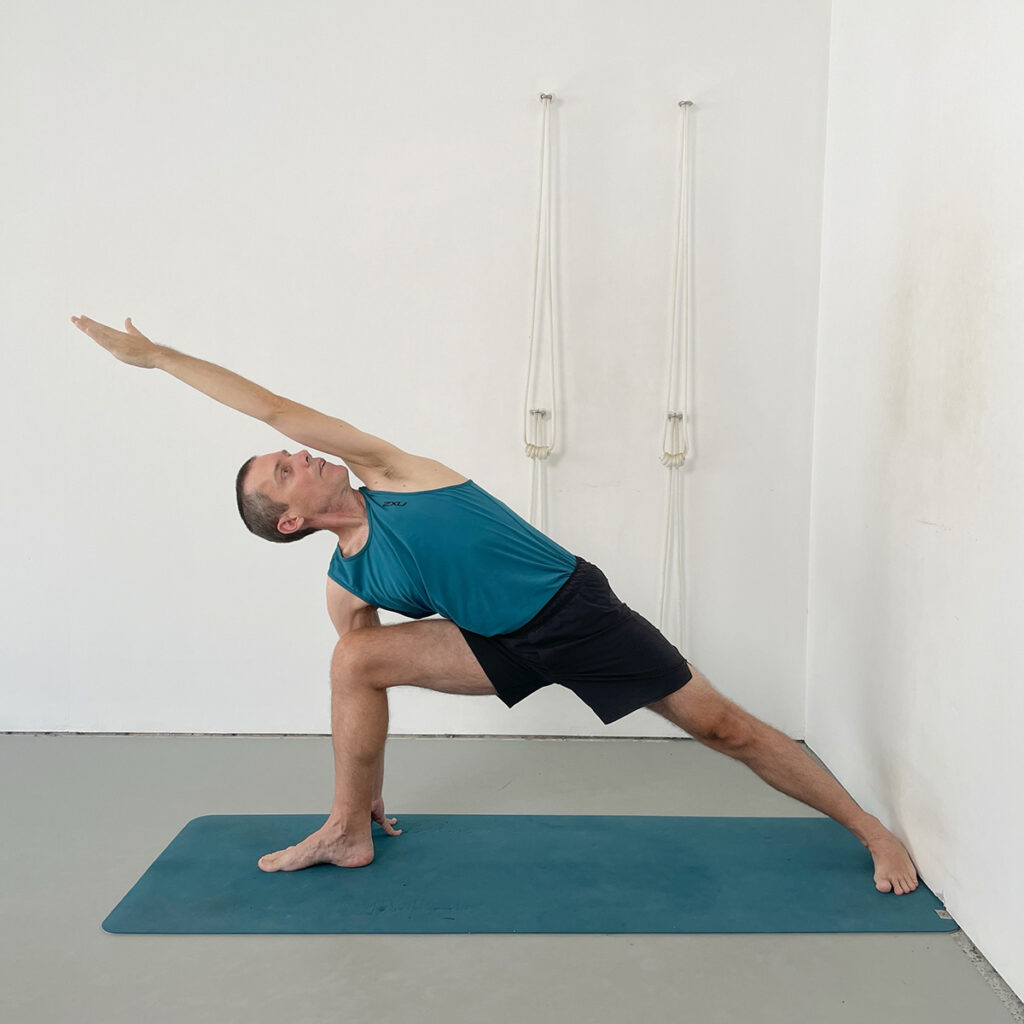
Technique Focus: Integrate all previous techniques to perform the full classical pose with deep waist-to-thigh contact, rotation, and extension.
- Place the back heel to the wall and step the front foot out to a wide distance (slightly greater than one leg’s length), then bend the front knee.
- Bring the bottom hand to the floor beside the outer foot.
- Press the front knee back into the arm and maintain waist-thigh contact.
- Turn the chest and waist upward while extending the top arm.
- Lengthen the arm fully over the ear, turning the head to look upward.
Conclusion
Working through these nine variations allows you to systematically deconstruct and rebuild your Parsvakonasana practice. Each variation isolates essential actions—strengthening the legs, opening the hips and shoulders, and refining spinal rotation—so that the final pose becomes more integrated, stable, and expansive.
About Rod Stennard

Rod Stennard – Founder of Yoga Selection
Rod Stennard is the founder of Yoga Selection, the first online yoga platform dedicated entirely to Iyengar Yoga. A certified Iyengar Yoga teacher since 2002, Rod has practiced yoga since 1992 and studied under senior teachers from around the world, including members of the Iyengar family in Pune, India.
Rod launched Yoga Selection in 2016 to bring structured, high-quality Iyengar Yoga training to a global audience. As a pioneer in the field of online yoga education, he is passionate about making this method accessible to all, through rigorous, inclusive, and thoughtfully designed classes. His work continues to support students of all levels in over 50 countries.
Explore Specialised Yoga Courses at Yoga Selection
Ready to deepen your standing pose practice even further? Explore hundreds of detailed Iyengar Yoga classes, step-by-step tutorials, and complete courses at Yoga Selection — your online home for methodical, transformative yoga education.
As a Yoga Selection member, you gain unlimited access to our extensive video library, featuring over 900 on-demand classes. Additionally, explore a diverse range of courses, with two new videos released every week.
Experience the flexibility of joining live classes in real time, allowing for personalised guidance and support. Immerse yourself in a vibrant community that nurtures your growth and provides valuable resources for your yoga practice.
Explore a World of Online Yoga. Unlimited Access to All Classes and Courses.
Try it Free for 14 days. Cancel Anytime.
Share:
See Related Blog Posts:
